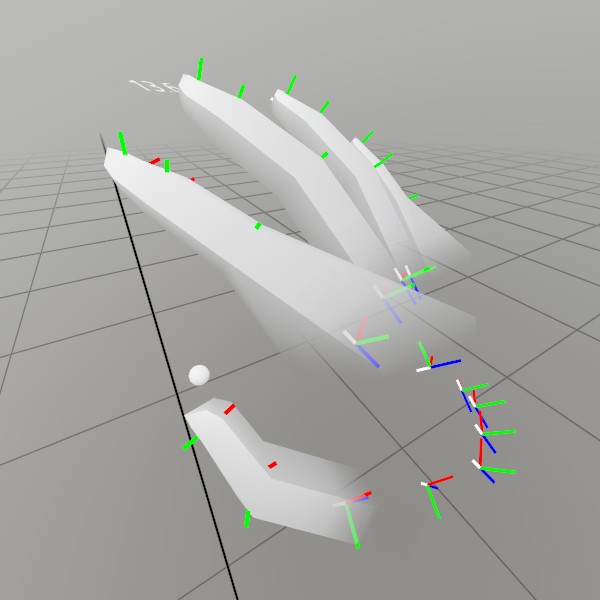Using Hands
StereoKit uses a hands first approach to user input! Even when hand-sensors aren’t available, hand data is simulated instead using existing devices! For example, Windows Mixed Reality controllers will blend between pre-recorded hand poses based on button presses, as will mice. This way, fully articulated hand data is always present for you to work with!
Accessing Joints

Since hands are so central to interaction, accessing hand information needs to be really easy to get! So here’s how you might find the fingertip of the right hand! If you ignore IsTracked, this’ll give you the last known position for that finger joint.
Hand hand = Input.Hand(Handed.Right);
if (hand.IsTracked)
{
Vec3 fingertip = hand[FingerId.Index, JointId.Tip].position;
}
Pretty straightforward! And if you prefer calling a function instead of using the
[] operator, that’s cool too! You can call hand.Get(FingerId.Index, JointId.Tip)
instead!
If that’s too granular for you, there’s easy ways to check for pinching and gripping! Pinched will tell you if a pinch is currently happening, JustPinched will tell you if it just started being pinched this frame, and JustUnpinched will tell you if the pinch just stopped this frame!
if (hand.IsPinched) { }
if (hand.IsJustPinched) { }
if (hand.IsJustUnpinched) { }
if (hand.IsGripped) { }
if (hand.IsJustGripped) { }
if (hand.IsJustUngripped) { }
These are all convenience functions wrapping the hand.pinchState bit-flag, so you
can also use that directly if you want to do some bit-flag wizardry!
Hand Menu
Lets imagine you want to make a hand menu, you might need to know if the user is looking at the palm of their hand! Here’s a quick example of using the palm’s pose and the dot product to determine this.
static bool HandFacingHead(Handed handed)
{
Hand hand = Input.Hand(handed);
if (!hand.IsTracked)
return false;
Vec3 palmDirection = (hand.palm.Forward).Normalized;
Vec3 directionToHead = (Input.Head.position - hand.palm.position).Normalized;
return Vec3.Dot(palmDirection, directionToHead) > 0.5f;
}
Once you have that information, it’s simply a matter of placing a window off to the side of the hand! The palm pose Right direction points to different sides of each hand, so a different X offset is required for each hand.
public static void DrawHandMenu(Handed handed)
{
if (!HandFacingHead(handed))
return;
// Decide the size and offset of the menu
Vec2 size = new Vec2(4, 16);
float offset = handed == Handed.Left ? -2-size.x : 2+size.x;
// Position the menu relative to the side of the hand
Hand hand = Input.Hand(handed);
Vec3 at = hand[FingerId.Little, JointId.KnuckleMajor].position;
Vec3 down = hand[FingerId.Little, JointId.Root ].position;
Vec3 across = hand[FingerId.Index, JointId.KnuckleMajor].position;
Pose menuPose = new Pose(
at,
Quat.LookAt(at, across, at-down) * Quat.FromAngles(0, handed == Handed.Left ? 90 : -90, 0));
menuPose.position += menuPose.Right * offset * U.cm;
menuPose.position += menuPose.Up * (size.y/2) * U.cm;
// And make a menu!
UI.WindowBegin("HandMenu", ref menuPose, size * U.cm, UIWin.Empty);
UI.Button("Test");
UI.Button("That");
UI.Button("Hand");
UI.WindowEnd();
}
Pointers
And lastly, StereoKit also has a pointer system! This applies to more than just hands. Head, mouse, and other devices will also create pointers into the scene. You can filter pointers based on source family and device capabilities, so this is a great way to abstract a few more input sources nicely!
public static void DrawPointers()
{
int hands = Input.PointerCount(InputSource.Hand);
for (int i = 0; i < hands; i++)
{
Pointer pointer = Input.Pointer(i, InputSource.Hand);
Lines.Add (pointer.ray, 0.5f, Color.White, Units.mm2m);
Lines.AddAxis(pointer.Pose);
}
}
The code in context for this document can be found on Github here!
Found an issue with these docs, or have some additional questions? Create an Issue on Github!
